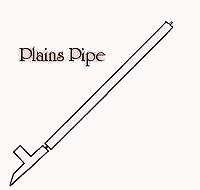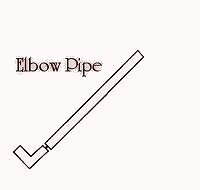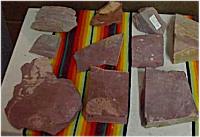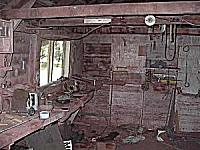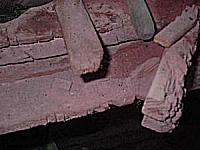Pipestone,
Pipes and the Stone
Including
a question and answer section
The
Prairie here in Pipestone is superb, untouched in it's beauty,
quiet and peaceful with insects buzzing, and birds singing
happily. The only sounds heard are those of nature, not
of man. This is Pipestone, a place of energies that begin
at the quarry areas, but permeate the town. These energies
are primal, basic, and powerful. It is because of those
energies that the Native Americans of yester-year knew that
this place was special. They knew that it had to be cared
for because Wakan things happen here.
The
different basic styles of pipes are as follows:
|
|
|
|
|
This
is a Plains or 'T' shaped pipe. This is the most
popular of the styles. It can be made in various
sizes, and can have a round or square shank.
|
This
is an 'Elbow' or woman's pipe. The bowl is smaller
and so doesn't use up as much stone as the other
two pictured here.
|
This
is a 'Four Winds' pipe. The engravings can be on
the shaft, bowl or both. Some have 4. some 7, or
which ever they feel is correct for them
|
Other
popular styles are the claw, and effigy pipes
The
stone that is quarried here by Native American's is still
used to make the Sacred Pipe. Each Pipe is different as
all are made by hand, using tools such as hacksaws, and
files. The stone is very soft and easier to fashion than
a regular stone. Of course the Ancestors would use a much
harder stone to carve the Pipestone, instead of using
the tools which are used today. Chuck has actually made
a Pipe using three different sizes of flint scrapers,
and a stone point attached to a stick to drill the holes.
Chuck says, 'If you are going to make it that way, make
sure you have lots
of time'.
It takes long, hard labor to reach the Pipestone in the
quarries, sometimes the quarrier can be in his quarry for
a month or more before getting to the soft red layer, which
is lying under the second hardest rock in the world, quartzite
(see photo below). He has to reach the Pipestone layer using
only hand tools, and his own strength and abilities. Just
hitting the quartzite doesn't make a dent all that achieves
is a bunch of sparks. It takes knowledge to quarry the stone,
and because of that many people leave the quarries empty
handed after trying for days to break through the hard rock.
Only those with the ancient knowledge actually come away
with the soft stone.
Chuck
Derby had that knowledge passed to him by his father
and grandfather. He works the same quarry that they
used. He now stands swinging a sledgehammer, only a few
yards from where his father stood years ago doing the same
thing, and he too stood not far from the spot where Chuck's
grandfather, Moses Crow, allowed his sweat to join with
the Earth Mother as he worked in the hot sun to reach the
beautiful red stone.
Some
people feel that Pipestone articles should not be sold.
However the quarriers, Pipe-makers and craftspeople feel
that the cost of the items compensates them for their time
either quarrying or crafting. They are not selling the stone
itself just their time
to quarry and make the items.
I often feel like saying to the people who complain about
having to pay money for pipestone articles, 'Well now here
is a shovel, sledgehammer, chisel, and wedges, there is
the quarry. Now go down there and dig out some stone, it
will take you a few months, but that's OK, when you come
out I want you to give me the stone you have dug out'. I
could imagine the answers I would get, and they wouldn't
be nice! Believe me, none of the 'Original Pipestone Dakota
Tiospaye' is making a financial gain at these prices, they
are only getting enough to keep them away from welfare.
We
were asked how many pipes we have 'sold' at the Center over
the 3 years before Spirit of Peace Crafts was started
because some people thought we were selling too many pipes,
(all Pipes now go through and from SOP) we worked
it out and the total came to 50. However the 'sale' is for
the time it takes for Chuck to quarry to get the stone and
for the time it takes the craft worker to make the Pipe.
Some of these Pipes Chuck made himself as custom pipes,
and some of those pipes were exchanged for a blanket or
tobacco. The majority available at the Center (pre SOP)
came from the Indian Shrine Assn. at the Monument, this
was the Center's way of supporting the Shrine.
Chuck
does not do things for money, many think that either he
is nuts or telling lies. However anyone who knows Chuck
can see that he does things in a spiritual way, and follows
what Spirit tells him. He is as the old people were, money
was unheard of, people helped one another and not for what
they could get from it. It is the way we all should be towards
each other, it is not a crazy way to be, but very natural
for those who live a natural lifestyle. I am proud to say
that those who visit, work or volunteer at the Center all
feel the same way. The Center draws the people who understand
that way. Like draws like, as the saying goes, and that
is really true at the Center. The Center is all about education,
not making money, or selling Pipes. The pipes are promoted
as is the true Pipestone; Catlinite. When people want a
pipe or stone we recommend where they should go to find
what they need. A place that benefits the maker of the pipe
and the People.
Chuck has been accused of being against the other organization
in town because they sell more than he does, and they make
more money, this again is completely wrong as Chuck's ideal
is not money but spirituality. He gets his pension and for
him that is enough. The Creator makes sure that things happen
to allow the Center to continue running, and that is the
main thing.
Summer
2003:
We
have many people sending in questions mainly about the various
aspects of the stone and quarrying. We understand that there
are queries that need to be sent in to us and that is fine
but maybe the question that you have will be among those
and you will get the answer immediately instead of having
to wait for Chuck to answer. Take a look below and see if
your question is there.
N.B.
We know that a Pipe is spiritually a Channupa, however we
hold them when they emerge new to the world, before they
are blessed to metamorphose as the Channupa, so in these
questions we use the generic name 'pipe' in the answers.
This is not done to be disrespectful to the Channupa.
Q: I
am a stone sculptor. I am wondering if there is a pipestone
quarry where a person like myself can go and pick up a few
raw chunks of pipestone for carving.
A:
Unless you are an enrolled member of a federally recognised
Native American Tribe you will not be able to quarry or
even help someone else quarry. The Catlinite cannot just
be picked up it has to be quarried for. The stone that lays
around on the top of a quarry is actually the Sioux Quartzite,
the second hardest rock in the world. It cannot be carved.
Below is a photograph of a quarry showing where the Catlinite
lays. The Catlinite is the maroon layer near the hammer
head.
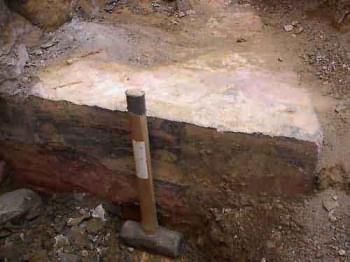
That
looks easy enough doesn't it? However above that part is
shown in the next picture, it is sioux quartzite and that
needs to be broken through first. That is not an easy job.
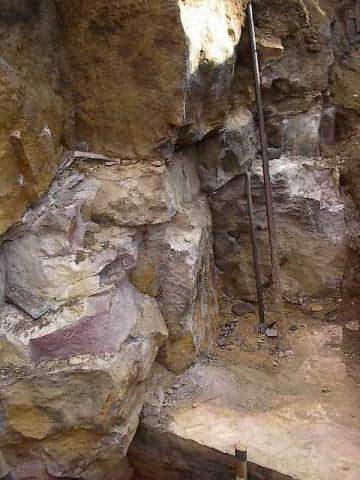
Q: I
would like some further instruction on the tool's, technique's,
and ceremonial proceedure to make a pipe.
A:
The tools are listed on our instruction
page, but the techniques cannot be shown on a web page.
If you are really interested in learning more please contact
Chuck to see if he can fit you into one of his pipe making
groups, they are small classes and you will watch him making
a pipe and will make one yourself under his watchful eye
and helpful hands. Ceremonial aspects of course cannot be
taught, they are already in each pipe, and as each is different
they need different ceremonials, the stone will speak to
you and tell you what it needs. That cannot be taught.
Q: I
was wondering if you had any information on Catlinite or
Pipestone being found in Texas/ Arizona/Ohio/Canada/Wisconsin/South
Dakota/Kansas. etc.(We
have the same questions about all of these states)
A:
Yes we know about the (?) stone, and do have some that
we bought from Ebay just to see what it was like. It is
usually very hard, shiny, and hard to carve. It is a similar
color to Catlinite but the texture is not at all similar.
It is often offered on Ebay, along with other types that
are called pipestone, and we have bid on and won most of
the different types so that we can show in our museum what
people are saying is pipestone.
|
|
|
|
The
stone that we got from Ebay is on the left and the
true Catlinite are the 6 pieces on the right in the
photo. Can you tell the difference
|
Close
up of the false stone. All of these were called Pipestone
or Catlinite on Ebay
|
We
let visitors handle and cut the various stones including
Catlinite and they see the difference immediately. None
of the stones have the same texture and workability that
Catlinite has. Catlinite has a specific chemical break-down,
(see Catlinite page) that no other stone has. Specimens
of this stone from the 'Great Pipestone Quarry'
were sent to Boston by George Catlin to be analyzed, recently
more specimens have been analyzed and the break-down is
the same. The stone has been named after Catlin because
he first brought it to the attention of scientists in 1836
and there was no match to this kind of stone. As far as
we know there is still no match for it, it is an extra special
stone from the Creator. The closest to it is the Jasper
stone as it comes from close to here but even that is harder
than ours. I guess thats why the old ones chose it to make
their pipes from when they first found it, they recognized
something very Wakan.
Q: Your
statement that jasper dust has no healing qualities disagrees
with the common wisdom of people from countries all over
the world for thousands of years. Red jasper is known to
spiritual people everywhere as a stone of physical regeneration
and healing, and I myself have used it in rituals for healing
to good effect. Stating that jasper is not the same as red
pipestone is true, but I believe you erred when you said
that it has no healing qualities.
A:
The Jasper that you are speaking of is completely different
to the stone we speak of. Jasper is the name of the town
where this other stone comes from, It is not the ancient
Red Jasper that is used in healing. This stone we speak
of is very similar to Catlinite, a grainy clay, yours is
a completely different make up. Most people who come to
the site know about the Jasper stone because they have experienced
it, and they are looking for the genuine Catlinite, so there
isn't that confusion with the name. We do understand though
that not everyone knows about it and so we should do a disclaimer.
Thank you for bringing it to our attention. We go crazy
every time we see 'pipestone' as a description of a stone
on Ebay. It comes in all colors, from various places, however
it doesn't come from Pipestone, although people believe
that it does and so the confusion starts. Sorry if we have
caused the same confusion with Jasper.
Q: At
a high school I know they have been grinding up pipestone
with a power grinder, spreading a fine red dust throughout
the Industrial Arts room. The teacher is wondering if there
are any toxic affects from exposure to the dust, either
long term or short term.
A:
First let me tell you that if they are using the true
Catlinite there is no problem. However if the false stone
is used then there will probably be a problem. The two stones
give off completely different dust. What are they making
that it needs to be ground up???? Hand tools have always
done the job sufficiently for centuries. Hearing of the
way the people are using these power tools tend to make
us believe that the stone is not Catlinite. The genuine
stone from the sacred quarries is very soft, and would crack
and break if a harsh tool is used on it. To shape it only
a regular hand file is used. See below for two pictures
of a shed that had been used for many years by a Pipe maker
in Pipestone. You can see the dust that is around, this
is normal yet none of the Pipe makers/artisans have ever
had problems with it. The Jasper stone on the other hand
is much sharper and grittier, and could probably cause problems,
we would think, if it is breathed in for many years like
Catlinite is.
Q: I
want to do this only in a Good Way, so please let me know
if this is not my place to go ahead with getting a pipe?
or I know the pipe bearer is chosen but is it
OK for me to obtain a pipe this way? or
Can you tell me if I should get a Pipe?
A:
We feel that the issue of if you should have a Pipe
or not is between you and the Creator, a human cannot say
if you can or cannot have one. The only thing we will say
on this is that as long as you can be respectful to the
Pipe and what it stands for, and you use it in the correct
way we have no problem with you having one. However you
must pray on it or find a Pipe that calls to you, as many
do. It is a big responsibility to be the holder of a Pipe.
Q:
My wife is pregnant and wants to know if it is ok
to touch the stone? or I have heard that women shouldn't
touch a Pipe is that true?
A:
Many people feel that women do not belong around the Pipe,
we believe that is wrong, after all where did the Pipe first
come from? The White Buffalo Calf Woman. If she can be in
a position to be able to bring such a gift to the People
then surely the Creator smiles on women having a Pipe. The
only time a woman should not be near the Pipe or the stone
is when she is on her moon time as at that time she is very
powrful and could redirect the power of the pipe/stone.
Q:
I've been cutting my catlinite pipestone with handsaws,
coping saws and i've even tried with a 2 speed jigsaw. I
keep destroying the saw blades rather quickly. What type
of blade can you suggest that will make a good cut without
losing the teeth off of it so fast?
A:
I suspect you have the Jasper red stone, you are not alone,
I have had many complaints about that stone. I have been
told its so hard it can't be cut with a hacksaw and it breaks
their tools; when its drilled, it splits apart; or if a
pipe is made and drilled, when the stem is inserted, it
splits. True catlinite doesn't do that, we cut it with a
hacksaw (I can cut quite a few pipe bowls with the same
saw blade), ordinary files to shape it and sand paper to
smooth it.
Q: I
have heard that if the Catlinite is old or has been in the
sun that you should wet it because the stone dries out,
is that correct?
A:
No that isn't right, Catlinite can be carved at any
time no matter how old it is, or where it has been kept.
We believe that this folk tale began because Catlinite is
a metaphorphic clay and dried clay is useless, however this
stone has been blending into it's constistancy for many
hundreds of years and the elements have no impact on it.
Q:
I was told that you should always make your own pipe...
or the pipe should always be gifted..... Is
that right?
A:
Well it would be nice if that could happen, but in many
cases that isn't so. People cannot always get hold of the
right stone or they feel uncomfortable making something
that they have no idea how to go about doing it or they
may be unable to make one because of their age or a disability.
In the old days each tribe would have a craftsperson who
could make pipes for the people who couldn't make one. We
believe that our family did this work because we know they
were quarrying in 1862 to take the stone back to make pipes
for the People. From the stories handed down this was not
the first time they had been to Pipestone to quarry. So
if you want us to craft your pipe for you you will be allowing
us to continue a tradition handed down to us from our ancestors.
As to gifting a pipe, many people do not belong to a circle
of people who even know they follow the Red Road and so
have no-one to gift them a pipe. However when you get a
pipe from us it is a gift because you only pay us for the
time to quarry the stone and make the pipe for you. The
actual pipe is free. Each pipe is wrapped in red cloth with
sage when it is sent to you, so it is wrapped very much
like a gift.
Q:
Should I even attempt to use the catlinite to make
the bowl, or would it be beyond me?
A:
Catlinite is easy to craft with as it is softer than most
stones, If you have the true Catlinite you should have no
problem. We will always help you in your quest, just ask
for assistance. Or you could attend one of Chucks pipe-making
classes if you are able to get here. Camping is free either
at the powwow grounds or the Center grounds.
Q: What
kind of tools are used to carve the bowl and stem?
A:
The
tools are listed on our pipe making instruction pages, but
I will relist them here as well.
Hacksaw,
Horse shoe rasp, 1/2 round file, Smoothing file, Sandpaper
(3 grits), 1/4” drill bit, 1/2” drill bit, Choice of electric
or hand drill, Wood plane, Pocket knife,
|
|
 |
|
Hacksaw
|
Horseshoe
Rasp
|
The
instruction page is HERE
|
These
questions are about polishing the stone
Q1: Is
there any way to polish the stone,so it will
shine?
Q2: When
immersing the pipestone pipe in the melted beeswax,
is it OK to allow the wax to coat the inside
of the pipe? Should I stopper the ends beforehand?
If not, what do I do to ensure a clear breathing
passage after the wax has dried?
Q3: What
materials do you recommend for buffing/finishing
the wax-coated pipe?
A:
Please DO NOT melt the beeswax!
All
you need to do is heat the pipe bowl in a bowl
of water, until the water boils and the pipebowl
gets hot, and then once it is hot tap the bowl
with a lump of beeswax so that a small amount
melts on the bowl. Then you quickly rub it all
over the bowl using a soft material, (an old
tee shirt would do the job) then put the bowl
in cold water to set it. when you take it out
of the water gently buff it with again a soft
material, any that has got inside the bowl or
any decoration can be removed with a fingernail
easily enough.
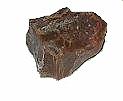
Beeswax
|
|
|
Q: Because
you can't quarry in the winter are you closed
now until spring?
A:
No
we are open all year long. However if you arrive
to find the place empty it will be because we
are out either running an errand or at a meeting
elsewhere. We leave a note on the door usually
saying when we will be back. The best thing
to do is to call or email first to make sure
we will be around when you arrive.
Q: Can
you come and give a talk to our school?
A:
Yes
we probably could come to you if we are available.
You will need to contact us to give us details
of what you want and where you are located.
We have spoken at most schools in SW Minnesota
and are used to putting programs together for
school age people. Please check the Beads &
Buckskins page for details on what subjects
we speak on, there is a good selection. Update
- We are sorry but Chuck has now retired from
doing talks outside of Pipestone County. If
Gloria is available she will still travel and
present the programs.
Q: Will
you send me more information on how to get genuine
pipestone.....
or
I do see "pipe stone" for sale on the web, large
pieces. One was 29#, cut off a much larger piece.
I question it's authenticity, is this the true
stone?
A:
You
can get the genuine Catlinite through us if
you would like to email us. Or come into the
Center to chose your own piece. As to the stone
on the web, we have no idea if it is genuine
or not. We suggest asking the seller where the
stone comes from and if the quarrier is in the
Pipestone Catlinite Quarriers Guild, and if
so his name. Then contact us again for confirmation.
Q: What
are the stems made from?
A:
Traditionally Sumac or Ash were used, today
pine is used a lot as well as the former two.
|
|

